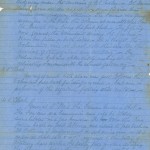Thu 2 Jun 2011
Dispatches from the Battle Field
Posted by Jim under History, John Miller/Thistle Ha'Comments Off on Dispatches from the Battle Field
Our history textbooks make fleeting reference to the “Fenian Raids” into Canada between 1866 and 1871. The Fenian Society was mid-19th century Irish-American movement agitating for Irish independence from Britain. Two factions developed, one supporting an Irish uprising, the other wanting to apply economic and political pressure on Britain by invading British North America. This second group mostly consisted of battle-hardened veterans of the American Civil War, commanded by former Union Col. John O’Neill. Just 13 months after the American war ended at Appomattox Court House, armed Fenians began crossing the Niagara River intent on seizing control of the Welland Canal, thereby strangling economic activity in Canada West (Ontario). The British were aware that Fenians had been gathering at the border, and had mobilized a militia force of Canadian volunteers in the Niagara frontier, including a battalion of the Queen’s Own Rifles, with Lt. Col. Alfred Booker in command. Most of the Canadian militia had never faced hostile fire. 145 years ago today, on June 2, 1866, the Fenians fought the Canadian volunteers just east of the railway station at Ridgeway, ON (approximately 15 km (9 miles) due west of Buffalo, NY) in what historians call the Battle of Ridgeway.
In the desk of John Miller/Thistle Ha’, I found a document that records telegraph dispatches during the Battle of Ridgeway. Writer is unknown, but clearly he was mobilized, awaiting orders to join the battle. Transcription is below.
Primary source: The Canadian Encyclopedia.
Document: Thistle Ha’ private collection.
Revised on August 20, 2011: Removed the word “British” in describing the source of the telegraph dispatches. In an email, Peter Vronsky noted the possibility that the telegraph dispatches were field reports from newspaper reporter(s). Dr Vronsky did his doctoral thesis on the Fenian raids into Canada West. His book on this subject is scheduled to be published in November 2011 by Penguin Canada – Allen Lane Canada in its History of Canada Series as Ridgeway: The American Fenian Invasion and the 1866 Battle that Made Canada.
By Telegraph
11 O’Clock
Last night the forces at Port Colborne were augmented by the University Company.
Early this morning the troops took the trains to Ridgeway under the command of Col. Booker.
Col. Dennis had gone on an expedition down the river three miles from Ridgeway Station.
The Fenians were found encamped in the bush, the column at once attacked them, the Queen’s Own firing the first shot.
The fighting now general, the volunteers driving the Fenians.
Number killed on both sides.
It is thought the volunteers will at least hold their own till the arrival of the regulars and artillery.
The volunteers behave splendidly rushing at the retreating Fenians with the utmost gallantry.2 O’Clock
An engagement took place near Port Colborne, the volunteers fell back for reinforcement.
Fort Erie in possession of the regulars, fighting still continues.4 O’Clock
General O’Neil the Fenian leader is shot.
The Fenians are hemmed in and will be totally annihilated in a few hours.
The volunteers have fallen back on Port Colborne and intend to fall back on St Catherines if reinforcements do not arrive soon.
It is reported that 16th and 47th regiments & their battery of artillery have reached the battle field and are driving the Fenians before them.
From Toronto.
Col. Lowry with 1000 men has just left for the scene of the action.This is all waiting for more news tonight.
Our company ordered to Toronto and very likely will leave that for the scene of action.
The document captures the essence of what happened that day, but with a decided pro-British spin. For example, if O’Neill was shot, it wasn’t mortal, since he led later Fenian raids into Canada. The initial success of the Canadian volunteers was against Fenian pickets. However, against the main Fenian force, they quickly broke and retreated until they met up with advancing British army 16th and 47th regiments. Learning of the approach of British regular army reinforcements pouring into the area by the trainload, the Fenians retreated back across the border. President Johnson’s response to this raid was swift. Recognizing that he could not ignore the folly of private American citizens fighting the British army on foreign soil, he insisted that American neutrality laws be strictly enforced, and ordered arrest of the Fenians en masse. Given the strength of the Irish immigrant vote, politicians on both sides of the border quickly decided to release captured or detained Fenians to return to their homes.
It is claimed that Ridgeway was the “battle that made Canada”, since the Fenian threat strengthened the resolve of the Canadian provinces to unify. So just 13 months after the Battle of Ridgeway, by act of British parliament, Canada gained its independence from Britain.

